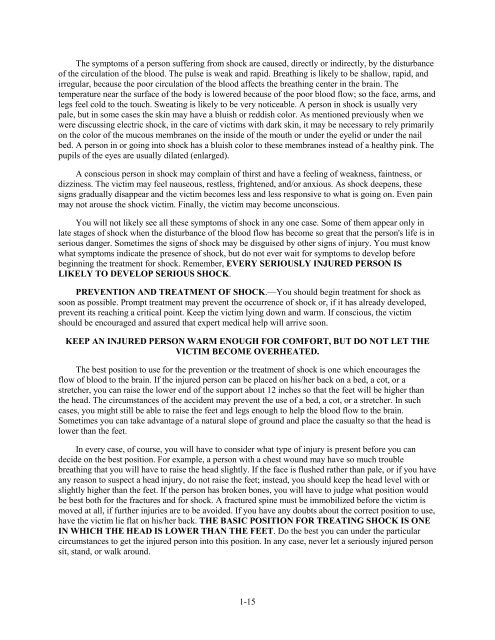Technicians Handbook - Historic Naval Ships Association
Technicians Handbook - Historic Naval Ships Association
Technicians Handbook - Historic Naval Ships Association
You also want an ePaper? Increase the reach of your titles
YUMPU automatically turns print PDFs into web optimized ePapers that Google loves.
The symptoms of a person suffering from shock are caused, directly or indirectly, by the disturbanceof the circulation of the blood. The pulse is weak and rapid. Breathing is likely to be shallow, rapid, andirregular, because the poor circulation of the blood affects the breathing center in the brain. Thetemperature near the surface of the body is lowered because of the poor blood flow; so the face, arms, andlegs feel cold to the touch. Sweating is likely to be very noticeable. A person in shock is usually verypale, but in some cases the skin may have a bluish or reddish color. As mentioned previously when wewere discussing electric shock, in the care of victims with dark skin, it may be necessary to rely primarilyon the color of the mucous membranes on the inside of the mouth or under the eyelid or under the nailbed. A person in or going into shock has a bluish color to these membranes instead of a healthy pink. Thepupils of the eyes are usually dilated (enlarged).A conscious person in shock may complain of thirst and have a feeling of weakness, faintness, ordizziness. The victim may feel nauseous, restless, frightened, and/or anxious. As shock deepens, thesesigns gradually disappear and the victim becomes less and less responsive to what is going on. Even painmay not arouse the shock victim. Finally, the victim may become unconscious.You will not likely see all these symptoms of shock in any one case. Some of them appear only inlate stages of shock when the disturbance of the blood flow has become so great that the person's life is inserious danger. Sometimes the signs of shock may be disguised by other signs of injury. You must knowwhat symptoms indicate the presence of shock, but do not ever wait for symptoms to develop beforebeginning the treatment for shock. Remember, EVERY SERIOUSLY INJURED PERSON ISLIKELY TO DEVELOP SERIOUS SHOCK.PREVENTION AND TREATMENT OF SHOCK.—You should begin treatment for shock assoon as possible. Prompt treatment may prevent the occurrence of shock or, if it has already developed,prevent its reaching a critical point. Keep the victim lying down and warm. If conscious, the victimshould be encouraged and assured that expert medical help will arrive soon.KEEP AN INJURED PERSON WARM ENOUGH FOR COMFORT, BUT DO NOT LET THEVICTIM BECOME OVERHEATED.The best position to use for the prevention or the treatment of shock is one which encourages theflow of blood to the brain. If the injured person can be placed on his/her back on a bed, a cot, or astretcher, you can raise the lower end of the support about 12 inches so that the feet will be higher thanthe head. The circumstances of the accident may prevent the use of a bed, a cot, or a stretcher. In suchcases, you might still be able to raise the feet and legs enough to help the blood flow to the brain.Sometimes you can take advantage of a natural slope of ground and place the casualty so that the head islower than the feet.In every case, of course, you will have to consider what type of injury is present before you candecide on the best position. For example, a person with a chest wound may have so much troublebreathing that you will have to raise the head slightly. If the face is flushed rather than pale, or if you haveany reason to suspect a head injury, do not raise the feet; instead, you should keep the head level with orslightly higher than the feet. If the person has broken bones, you will have to judge what position wouldbe best both for the fractures and for shock. A fractured spine must be immobilized before the victim ismoved at all, if further injuries are to be avoided. If you have any doubts about the correct position to use,have the victim lie flat on his/her back. THE BASIC POSITION FOR TREATING SHOCK IS ONEIN WHICH THE HEAD IS LOWER THAN THE FEET. Do the best you can under the particularcircumstances to get the injured person into this position. In any case, never let a seriously injured personsit, stand, or walk around.1-15
















